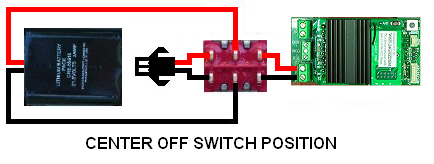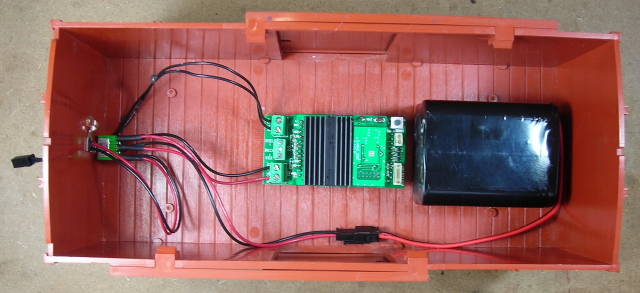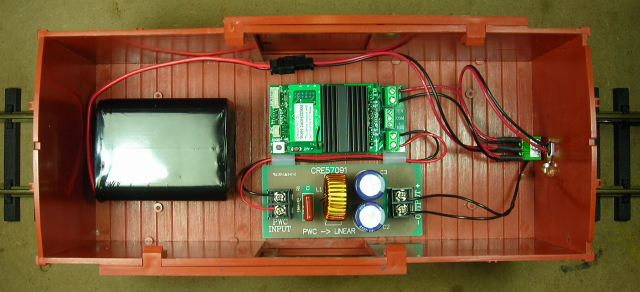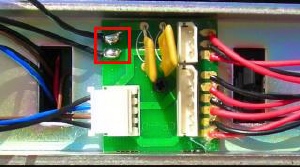TRAILING POWER AND CONTROL CAR CIRCUIT
The most common circuit found in battery power and radio control applications uses a switch to toggle an on-board battery pack between its charging plug and a radio control receiver. The following illustration shows the components used to build this simple circuit.
A battery pack is connected to the center terminals of a double-pole double-throw (DPDT), center-off switch. If an Aristo-Craft or Cordless Renovations lithium-ion battery pack is being used, it is not necessary to solder the battery pack wires directly to center terminals of the switch. One half of a 2-wire connector set can be soldered to the switch, and the battery pack just plugged into the connector.
A battery charger connector is soldered to the left terminals of the switch. If an Aristo-Craft or Cordless Renovations battery charger is being used, the second half of the 2-wire connector set can be used as the charging connector.
The input (track) wires of a Revolution receiver’s adapter board or Plug and Play Board are soldered to the right terminals of the switch.
Toggling the switch one way connects the battery pack to its charging connector. Toggling the switch the other way connects the battery pack to the receiver.
The 2-wire connector set and DPDT, on-off-on, mini-toggle switch are available from All Electronics under catalog numbers CON-240 and MTS-12 respectively.
CAUTION: The position of the wire colours on the connector sets sold by All Electronics are not positioned the same as the wire colours on connectors used for Aristo-Craft and Cordless Renovations lithium-ion battery packs and chargers. Click on the following link to see how to change the AE Connector Set Wiring over so that proper polarity is maintained.
Adding an MU connector to the output (motor) terminals of the Revolution receiver’s adapter board or Plug and Play Board allows any Aristo-Craft Plug and Play locomotive, or any other locomotive with an MU plug added and its track power pick-ups unplugged, to be battery powered and radio controlled using this simple circuit in a trailing power car.
The voltage regulators in most USA Trains and some LGB and Bachmann locomotives are not compatible with the PWC output of the Revolution receiver and the lights may not work properly. As most smoke units are powered by voltage regulators, they may not function either. Some older analog sound boards (Dallee, LGB, Sierra, etc.) may not function properly when powered with PWC.
Fortunately Aristo-Craft has released a PWC to Linear DC Board (CRE 57091) to fix this problem. With this board installed in the MU plug wires of a power car, all of these locomotives and sound boards should function as they did with clean DC track power.
Aristo-Craft, lithium-ion battery packs are rated for 2 amps and have a built-in circuit board to protect them from heavy use or rapid charging which could not only shorten their life, it could result in serious damage. Always use the proper charger when replenishing these battery packs.
As the lithium-ion battery pack is only rated for 2 amps, the fuses in the receiver’s adapter board or Plug and Play Board should be replaced with a smaller 2.5 amp or 3 amp fuses.
ON-BOARD BATTERY POWER AND RADIO CONTROL
The same simple circuit can also be used to provide on-board battery power and radio control in Plug and Play locomotives.
But the DPDT switch cannot be soldered directly to the receiver, as the receiver is mounted in the Plug and Play socket. To connect the switch, the locomotive’s redundant MU connectors are unsoldered and removed. The wires from the right terminals of the switch are then soldered to the engine’s circuit board in place of one of the MU connectors.
Although this same circuit can be used to provide on-board battery power and radio control in non Plug and Play locomotives, each installation is unique. To view articles on some of these installations, use the index in the Battery Power and Radio Control Installations section to select an appropriate article.






